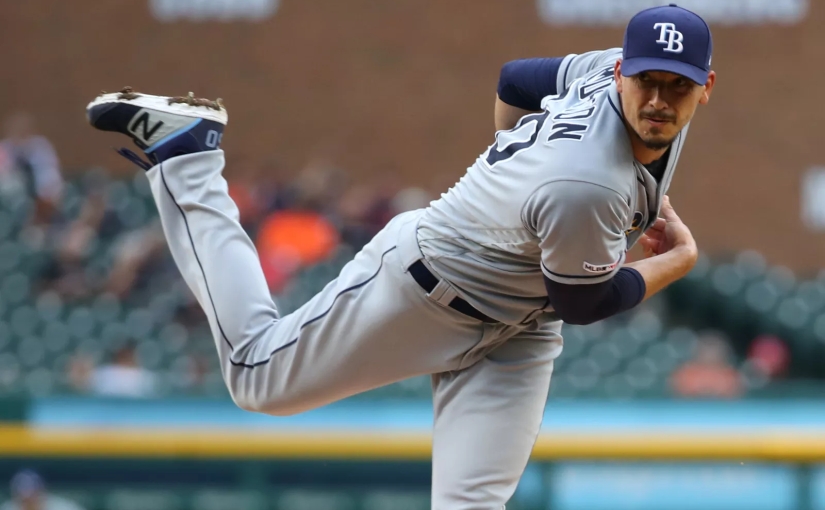
Charlie Morton is one of the world’s best pitchers. Don’t believe me? Here’s a quick piece of proof. Among all starters since 2017 (with enough innings, yadda yadda yadda) Morton’s xFIP is 13th best. His fWAR is 14th, ahead of Clayton Kershaw and Noah Syndergaard.
Sorta weird that he signed for so little last offseason, right (2 years, $30 million)? The Rays are a contender and Morton is the best and healthiest arm they have. He’s been excellent for them.
But … uh … the New York Yankees, Minnesota Twins, Cleveland Indians, Boston Red Sox, Chicago Cubs, Atlanta Braves and Philadelphia Phillies couldn’t have used Morton? (Imagining Morton on the Dodgers or back on the Houston Astros might break the space-time continuum. Just don’t.) I just don’t for the life of me get why teams weren’t willing to take this risk. Sure, he’s on the wrong side of 35, but the immediate track record is strong.
Hey, Brian Cashman. Defend re-signing JA Happ for an additional year versus Morton’s 2/30. Go ahead. I’ll be here.
Charlie Morton is good. Like, really good. Nothing has changed since signing with the Tampa Bay Rays, either; in fact, he’s probably only better. Morton has leaned even harder into that nasty curveball, throwing it more than anything else in his bag of tricks and finding elite results: .176 xwOBA (!!!!!!!), 37.9 percent whiff rate (!!!). The average exit velocity off that curve is 82 MPH, which is just ridiculous.
Seriously, that .176 xwOBA is absurd. Just bonkers. Remember, the expected weighted on-base average is driven by batted ball data and the expected performance therein. Hitters are doing nothing against Morton’s hammer. Given what we’ll see soon, that makes perfect sense. Morton doesn’t have a great fastball — the velocity is solid, the spin isn’t — but he knows how to work hitters into bad spots. And what’s a bad spot, you ask? Any count where he can unleash the curve.
Okay, I know the Detroit Tigers are bad. Wait, sorry, terrible. I know. But I wanted the chance to show you some of Morton’s best hammers, and so here we are. Last Friday, Morton squared off with Detroit’s finest. We’ll be working out of the first inning.
Morton sets ’em up and knocks ’em down
Victor Reyes is up first for the Tigers. Morton starts with a fastball up and away for strike one.
Note how simple Morton’s mechanics are. Easy to repeat, no obvious hinges or spots to get out of balance. I like that. If he wants to play around with timing, he can, but sometimes the best delivery is the simplest. Pitching is a complicated act; why make it harder?
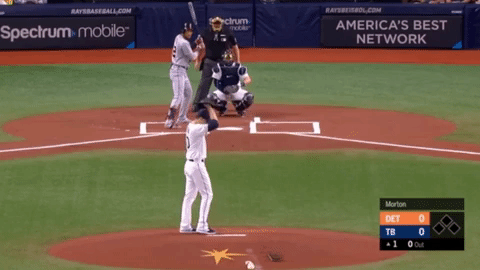
Morton sticks with the gas on the outside corner. Reyes knocks it foul. The velocity is pretty good — 95 MPH — but his average spin rate is pretty lukewarm. Still useful — 95 MPH is hardly Jamie Moyer territory — but Morton has to be careful where he uses it.
This is not one of those examples.
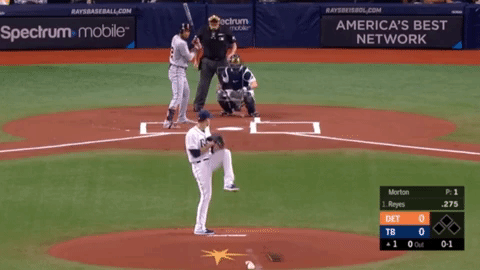
It’s hilarious to me that Morton kinda hung this curve and yet Reyes was frozen into a block of ice anyway. The arm angle barely changes from the fastball to the breaking ball; he doesn’t finish in any distinctive way. Yes, obviously, the curve looks a bit different out of the hand — the little bump there — but it doesn’t matter.
Nasty. Just nasty. Reyes is out with the good morning, good afternoon and good night sequence.

Check this bad boy out slomo:
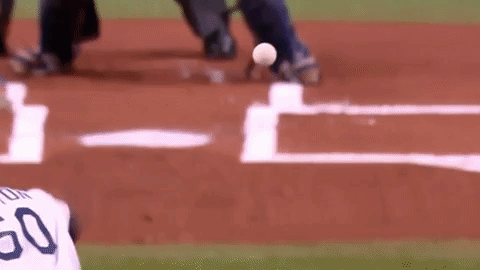
Dawel Lugo is up second for the Tigers. Morton leaves a fastball over the plate for called strike one. Advanced scouts and the folks putting together reports know far more than me — oh, don’t look so shocked! — but I do wonder against someone like Morton, is it smart to jump on the first fastball you see?
His fastball is certainly not a bad pitch, but it might be the best one to hit. Can’t dance with that curve, anyway.
Just a thought.
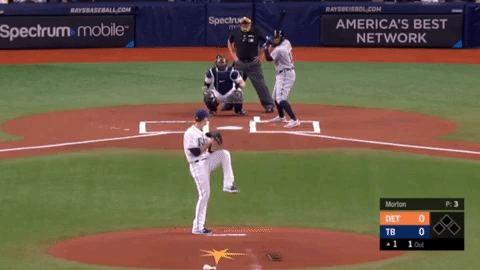
Morton turns to a cutter but misses below the zone. He doesn’t throw the cutter much (11 percent) and like the fastball, it’s an alright pitch (.348 xwOBA). Change of pace offering. He wisely uses the fastball, cutter and rarely-thrown splitter to give batters something beyond the curve to consider. Mixes and matches.
Morton has said the cutter helps him work in on lefties, which would seem evident based off the movement here.
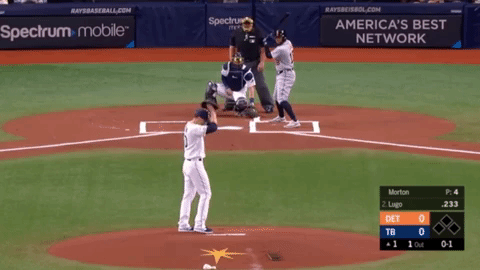
Morton is working for that second strike. (As you know, two strikes, boom, hammer time.) Ah, but Charlie Morton is not bound by such feeble pitching intelligence. He does not need two strikes to be worthy of the power of Thor, oh no, not at all.
Just ask Lugo, who flinches like he saw a wasp as Morton’s curveball drops in the zone for strike two. Man oh man, what a great look at how tough it is to hit against this guy. (Props to Tampa’s excellent straight-on camera angle, too!) Before the spin takes over, that looks like a fastball ready to drill Lugo in the ribs.
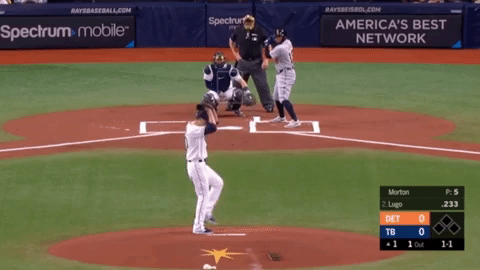
Poor Lugo. Morton twisted him into a pretzel and choked him out. This is like the sophomore getting dismantled by the senior in high school wrestling practice. This is oh-no-I-got-stuffed-in-a-locker-again material.
Morton used multiple parts of the zone and changed speeds in each. Look, it seems silly to say, but it’s that simple. The mechanics of pitching — the delivery, the grip, etc — are very complicated, no doubt. But the approach? The approach doesn’t have to be.
What is pitching, kids? Pitching is upsetting the batter’s timing. You can get there any which way ya want, but that’s the name of the game.
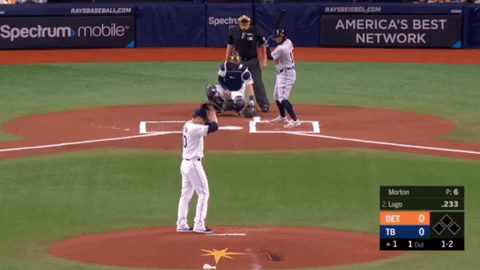
Last hope for the Tigers in the first is Miguel Cabrera. The future Hall of Famer is not aging gracefully — 98 OPS+ the last three years — driven mostly by injuries and age. Time defeats all, even Triple Crown winners.
Frankly, what Morton does here is just dirty. Another curve inside, another righty flinching out of the batter’s box. Look, no one bats an eye if you make Lugo flinch, but Miggy? Miggy? Sigh. Say you’re sorry, Charlie.
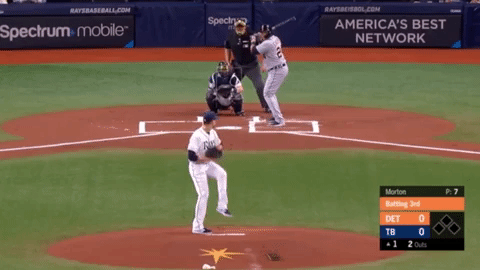
After the curveball from a split dimension, Morton tries to catch the outside corner with a fastball but runs it too far afield, ball one. Smart approach. Even Miggy would have to be a bit concerned about covering the inside corner after that curve; give him something else to ponder.
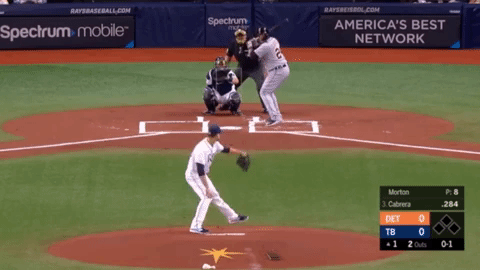
Morton tries it again and clips the zone with this one. Miggy flicks it foul. Cabrera isn’t the fastball-mashing machine he once was, sadly. One wonders what 2013 Miggy does with that pitch.
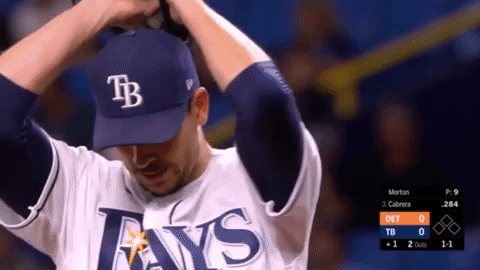
Morton has another Tiger in a two-strike count. He’s worked up and in and up and away. If you’re an excellent curveball thrower, this template is well-worn. Morton spins a curve right below the last fastball and Miggy waves at it for strike three.
No chance.

Curves, curves, curves
Morton is an impressive dude. I love writing about pitchers who don’t have the ultra stuff of a Max Scherzer or Jacob deGrom; guys like Morton or Patrick Corbin, who have one great pitch (Morton’s hook, Corbin’s slider) and the approach to get to counts where that pitch can do its job.
Morton, 35 years old, has a 159 ERA+ and a sterling 4.38 strikeout-to-walk ratio. He’s great, truly great, and no one’s idea of fun in a potential AL Wild Card game start.

